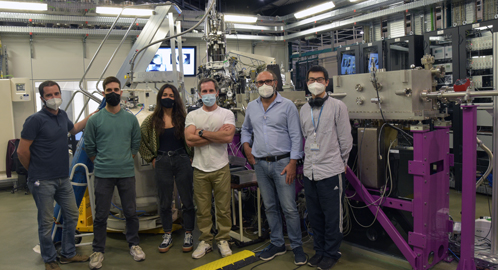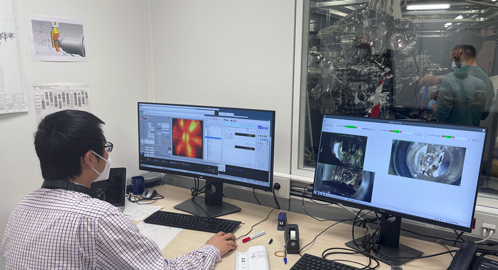

At the left, group picture of the team involved in the first official experiment at LOREA (from left to right: Jordi Prat, beamline technician, PhD student David Subires, master student Lorea Sánchez , IKERBASQUE researcher Santiago Blanco from DIPC Donostia, Massimo Tallarida, beamline responsible, and Ji Dai, postdoctoral research associate at LOREA). At the right, one of the spectra obtained during the experiment.
Cerdanyola del Vallès (Barcelona), 22nd October 2021. LOREA is the 9th beamline of the ALBA Synchrotron. It's devoted to the study of the electronic structure of solids using ARPES technique (high resolution Angle-Resolved Photo-Emission Spectroscopy). This new beamline is a very powerful tool for the scientific community specialized in the research of quantum materials.
After the construction and commissioning period, LOREA has now entered in full operation, receiving this week its first official users. They are a research group from the Donostia International Physics Center (DIPC), led by researcher Santiago Blanco.
The research group is analyzing the electronic structure of a promising 2D material, based on vanadium and selenium(II) (VSe2), with great possibilities for spintronics and data storage. This compound shows a charge density wave (CDW), meaning that electrons are ordered by generating periodical waves at the Fermi surface. "We want to check the effect of the structural disorder on the band structure as there is scientific literature reporting that suppressing the CDW can drive the material magnetic and, therefore, useful for spintronics and data storage, for example", says Santiago Blanco.
Using the LOREA beamline (lorea means flower in Basque), Santiago and his students (one of them also named Lorea) are obtaining high resolution flower-shape spectra of this compound in order to understand the Physics behind. "Coming to ALBA, users can have access to a wider range of energies, a greater intensity and the possibility to vary the energy and polarization for understanding the electronic and magnetic properties of these advanced materials", says Massimo Tallarida, beamline scientist in charge of LOREA.
The project is co-funded by the European Regional Development Fund (ERDF) within the Framework of the ERDF Operative Programme of Catalonia 2014-2020.
With the collaboration of Fundación Española para la Ciencia y la Tecnología. The ALBA Synchrotron is part of the of the Unidades de Cultura Científica y de la Innovación (UCC+i) of the FECYT and has received support through the FCT-20-15798 project.







